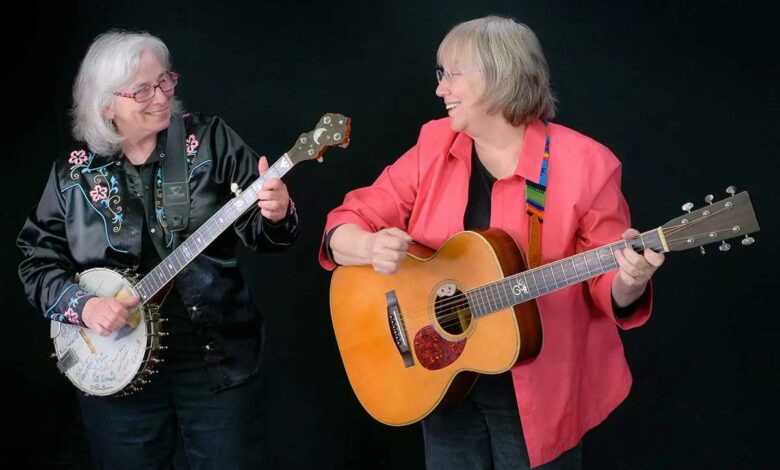Joining the Circle: Tips and Tactics for Making Music with Others


You’ve seen that T-shirt that reads “Plays Well with Others.” While many people perform solo, ensemble music can be a special delight but does require additional skills. Just as you need to have your act together about your own playing, you need skills in listening to and interacting with other musicians. You must learn to adjust to how others play, flex your music to fit, and ideally approach all of this with a warm and welcoming attitude.
We’ve been a duo for over 40 years, and have also worked in trios and larger ensembles in various styles of music, from folk to country to hot club jazz. We have participated in and led jam sessions where playing well with others necessitated taking on additional skills and sensitivities. In this feature, we’ll share some of the things we’ve learned along the way about how to approach playing with other musicians in any style.
Listen Up
Listening—not just passively but actively—is one of the primary skills involved in playing well with others, and it’s important not to overlook it as part of your practice regimen. How does deep listening affect your playing? The more songs and tunes you listen to, the more often you can hear similar chord changes shared by different pieces of repertoire—and that helps you train your ear.
With your instrument in hand, can you listen to a piece of music and figure out what the key is? That’s step one to acquiring and using these skills.
Next, do you recognize the chord progression? It might be as simple as I–IV–V (in the key of C major, C–F–G) or another recognizable pattern, such as I–VI–II–V (C–A–D7–G7). These changes are used in countless songs, and the more you recognize them by ear, the faster you’ll be able to find chords on your own.
Now you have the key, and you recognize the chord pattern. Can you figure out what meter the song is in? That of course will help you know what kind of strumming or picking pattern you’ll need. Listen for any surprises—perhaps an unexpected chord or a section that’s longer or shorter than is customary. Write out a full chart, and play along with a recording. If it’s too fast, you can change the playback speed on YouTube, or use software such as Amazing Slow Downer to put it under the microscope.
Using these aural skills in an ensemble setting will help you play with others much more fluently, and will make it that much easier to perform a new or familiar set of songs.
Get Visual
In addition to musical cues, there are visual cues to playing well with others. In a tight harmony vocal setting, for instance, the words start and end exactly together. Often there are vocal swoops or ornaments that are replicated in harmony. Visual cues make that much easier. In duo and trios, we often look at each other for these signals about how long to hold a note or when to start the next word.
As bandleaders, we often use visual cues to let folks know when we’re changing parts or ending a song. Sometimes it’s a nod of the guitar neck, and we’ve discussed what the signal will be. Other times leading group strum-alongs, we’ll use three different neck positions for the I, IV, and V chords, for instance, so that the crowd has a visual cue.
Find Your Place
In playing with others you have to think carefully about how your guitar fits into the bigger picture. For instance, when we are both playing guitar in our duo, we experiment with different options to find the best sound. Perhaps we’ll capo in different places—if we’re in C major, one of us might play without a capo using chord shapes in that key, while the other uses a capo at the fifth fret and plays chords in G. That gives the two guitars different sounds that blend beautifully.
While it might be tempting to get out your guitar and just start playing right away, sometimes it’s best to assess the situation and think through how you want to show up. Playing with or behind a vocalist requires careful attention to dynamics—your relative loudness or softness—along with tonal qualities, such as punchy, fluid, and sweet. When someone is singing, the voice and the lyrics are most important. You don’t want the guitar to be too prominent, and if you are playing lead lines, it’s important they don’t interfere with the lyrics. If there’s lots of space between vocal phrases, there might be room for guitar leads, but when in doubt, less is better.

Playing in an ensemble requires constant attention to the dynamics. You want to help other musicians be heard, and you want to be heard yourself when your turn for lead comes around. If others are not quieting down, you may need to play louder. Experienced jam leaders and players will generally be considerate of whoever is playing lead, but you may need to be flexible with when to just listen, when to play quietly, and when to be more assertive on your guitar.
Also be aware of what you are adding to the overall texture. If everyone’s playing boom-chuck rhythm, try a fingerpicking pattern instead of more of the same. And don’t be afraid to change your approach mid-song if you feel you want to try something different. As long as you can be respectful of the group sound, give it a whirl.
Build Your Repertoire
Part of the joy in playing comes from learning repertoire. There are thousands and thousands of two- and three-chord songs. Try a song with a new chord progression, and that harmonic sequence will most likely come around again. If you learn Woody Guthrie’s “This Land Is Your Land,” for example, you will internalize the chord changes and easily learn the next three- or four-chord song.
Memorize the songs you love. Create a notebook of your favorites, along with your preferred keys. As you add more songs to the list, every once in a while, go back and refresh on songs you haven’t played in a while. Even if you are a songwriter, the more tunes you learn by other musicians, the better informed you will be about songwriting—and by extension, the better equipped you’ll be to play with others.
The Canadian singer-songwriter James Keelaghan tells students that everyone should learn at least 50 songs by other writers to inform their own songs. Do you love fiddle tunes on guitar? Learn 20 each in the keys of D, G, and A. That’s 60 tunes you can play and jam on. If someone calls a tune that’s not on your list, it will likely have many of the same musical passages you can draw from in playing it on the fly.
Tune Up
It may seem obvious, but we’ll say it anyway: always take the time to get in tune. The joke “good enough for folk music” isn’t really that funny. One out-of-tune instrument can sour a whole session. Retune as needed. When you use a capo, you may need to adjust tuning. That’s normal. When you take the capo off, adjust tuning again as needed. This is a sign of consideration for others and respect for the sound you are bringing to the session.
You can politely help someone tune if it seems they are not in with the group. Just ask if they would like to borrow your electronic tuner, or if they seem to be more on the beginner side, you can offer to tune their instrument for them. With the right vibe, that person is more likely to feel appreciative than insulted. So, no heavy handed, “You’re out of tune, man,” but instead say, “Can we all please take a minute to retune? Does anyone need help with that?”
Mind Your Manners
Knowing that your participation in any ensemble situation affects everyone, and showing up with a sense of mindfulness and appreciation for others can go a long way. As a player, you can be supportive if someone needs help knowing when to change chords, for instance. You can do this gently, without calling attention to that person, by simply turning so they can see your hands. That person can learn by listening, watching, and following your fingers.
In jam sessions, sooner or later someone will suggest or play a song or tune you aren’t fond of. Maybe they just learned that tune and love it. They probably haven’t been to 20 sessions where it was overplayed. If the group goes ahead with the tune, just join in and give it your best. Or take a break if you want, without making that person feel uncomfortable.
As frequent instructors at music camps, we inform students of our no-noodling rule. Many people don’t actually know that they are noodling, simply because they are only paying attention to themselves. A jam session or ensemble leader can clarify this policy as needed and gently remind folks. If someone’s talking through a chord progression, showing a lead line, or introducing their song, noodling clutters the sound and makes it difficult for the group to play well together.
Communicate Well
Music is often called the international language, and language is communication. When playing with others, we need to develop clear communication about what music we’re going to play and how we’re going to play it. There are several ways to do that. You can talk through the chords before everyone plays; you can demonstrate a verse and chorus. Often, we’ll sing the chords to the melody as we play them and ask people to join in that process. When it feels like everyone’s on the same page, then we can officially start the song with strong group participation.
Sometimes, people in jam sessions choose songs that aren’t really accessible to others. Again, communicating in advance can help this. If you ask how many folks know a song you’d like to lead and there’s not much response, you might want to table it and choose something more participants are familiar with. The point of a jam session or ensemble work is to play together. If others don’t know the material and can’t learn it quickly, make a different choice.
Communication is key to leading a song. You can utilize different methods of cueing a group that a new section or different chord is coming, whether a nod of the head or nod of the guitar neck. In old-time music, we often signal the end of a tune with a lifted foot. Another approach is to verbally prepare folks in advance, as in “Two A sections, two Bs, one C, then back to two As.” Be as clear and specific as you can.
There are multiple valid versions of so many songs and tunes. In fiddle tune sessions, we often discuss which version we want to play before kicking off a tune. We might need a reminder of how that version goes, and someone will play it through once for that reminder. If the tune hasn’t been on our radar for a while, or it’s particularly crooked with odd numbers of beats in certain sections, we may need a reminder of the chords or when they change. That’s part of the conversation we talked about earlier. But it is also how we learn new tunes and songs and enjoy them in group settings—which can be the most rewarding and satisfying for making great music.
Session Starters
In the acoustic guitar world, there are countless common repertoire songs that are widely appreciated for their catchiness and accessibility. These suggested tunes are the tip of the iceberg, but will go a long way toward getting you started.
—CF and MM
Folk
Freight Train
Good Night, Irene
Hand Me Down My Walking Cane
The Last Thing on My Mind
Michael, Row Your Boat Ashore
Midnight Special
Red River Valley
This Land Is Your Land
Turn! Turn! Turn!
Will the Circle Be Unbroken
Bluegrass/Old-Time
Blue Moon of Kentucky
Good Old Mountain Dew
I’ll Fly Away
Mama Don’t Allow
New River Train
Old Joe Clark
Rocky Road Blues
Salty Dog Blues
Shady Grove
Soldier’s Joy
Country
Blue Eyes Crying in the Rain
Blues Stay Away from Me
Bye Bye Love
Coat of Many Colors
I Walk the Line
In the Pines
Jambalaya
Ring of Fire
The Tennessee Waltz
Waiting for a Train
Jazz/Swing/Western Swing
Ain’t Misbehavin’
Autumn Leaves
C Jam Blues
Fly Me to the Moon
I’ve Got Rhythm
Minor Swing
My Window Faces the South
On the Sunny Side of the Street
Sweet Georgia Brown
Take Me Back to Tulsa
Cathy Fink and Marcy Marxer are acclaimed singer-songwriters, multi-instrumentalists, and music educators. The two-time Grammy-winning duo has released 51 recordings, won recognition as both songwriters and tradition bearers, and opened doors for countless other musicians. cathymarcy.com
This article originally appeared in the July/August 2024 issue of Acoustic Guitar magazine.




